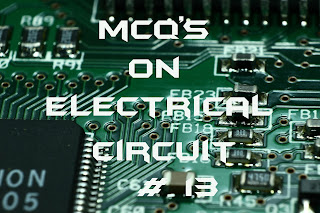Hi friends, these are some of the multiple choice questions on electrical circuits. These are some of the basic questions which are asked in previous competitive papers check out and comment...
1) Parallel resonant circuit is sometimes called as
A) Acceptor circuit
B) Rejector circuit
C) Inductive circuit
D) Capacitive circuit
Ans:B
2) When two pure sine waves of the same frequency and the same amplitude which are exactly 180° out-of-phase are added together, the result is
A) A wave with twice the amplitude
B) A wave with half the amplitude
C) Zero signal
D) A wave with twice the frequency
Ans:C
3) If two complex conjugates are added, ............ components results.
A) In-phase
B) Quadrature
C) Complex
D) Out-of-phase
Ans:A
4) If an emf in circuit A produces a current in circuit B, then the same emf in circuit B produces the same current in circuit A. this theorem is known as
A) Maximum power transfer theorem
B) Millman’s theorem
C) Reciprocating theorem
D) Norton’s theorem
Ans:C
5) According to Gauss theorem, flux can be equated to
A) Charge
B) Field intensity
C) Current
D) Voltage
Ans:A
6) An open resistor when checked with an ohmmeter reads
A) Zero
B) Infinite
C) High but within the tolerance
D) Low but not zero
Ans:B
7) Norton’s theorem is .................... Thevenin’s theorem.
A) The same as
B) The converse of
C) Older that
D) More accurate than
Ans:B
8) What value of R is needed with a 0.05 𝛍F C for an RC time constant of 0.02 s?
A) 400 Ω
B) 400 MΩ
C) 400 GΩ
D) 400 kΩ
Ans:D
9) Which of the following is the statement of Ohm’s law?
A) Electric current is directly proportional to both voltage and resistance
B) Electric current varies directly as the voltage and inversely as the resistance
C) Electrical power is directly proportional to the resistance and inversely as the current squared
D) Electrical power is directly proportional to both voltage squared and the resistance
Ans:B
10) The admittance of a parallel RLC circuit is found to be the ..... sum of conductance and susceptances.
A) Algebraic
B) Arithmetic
C) Vector
D) Phasor
Ans:D
If you like my post please share it with your friends and subscribe to latest updates.. If you have doubts you can start new topic on forum and start discussion with our readers..
1) Parallel resonant circuit is sometimes called as
A) Acceptor circuit
B) Rejector circuit
C) Inductive circuit
D) Capacitive circuit
Ans:B
2) When two pure sine waves of the same frequency and the same amplitude which are exactly 180° out-of-phase are added together, the result is
A) A wave with twice the amplitude
B) A wave with half the amplitude
C) Zero signal
D) A wave with twice the frequency
Ans:C
3) If two complex conjugates are added, ............ components results.
A) In-phase
B) Quadrature
C) Complex
D) Out-of-phase
Ans:A
4) If an emf in circuit A produces a current in circuit B, then the same emf in circuit B produces the same current in circuit A. this theorem is known as
A) Maximum power transfer theorem
B) Millman’s theorem
C) Reciprocating theorem
D) Norton’s theorem
Ans:C
5) According to Gauss theorem, flux can be equated to
A) Charge
B) Field intensity
C) Current
D) Voltage
Ans:A
6) An open resistor when checked with an ohmmeter reads
A) Zero
B) Infinite
C) High but within the tolerance
D) Low but not zero
Ans:B
7) Norton’s theorem is .................... Thevenin’s theorem.
A) The same as
B) The converse of
C) Older that
D) More accurate than
Ans:B
8) What value of R is needed with a 0.05 𝛍F C for an RC time constant of 0.02 s?
A) 400 Ω
B) 400 MΩ
C) 400 GΩ
D) 400 kΩ
Ans:D
9) Which of the following is the statement of Ohm’s law?
A) Electric current is directly proportional to both voltage and resistance
B) Electric current varies directly as the voltage and inversely as the resistance
C) Electrical power is directly proportional to the resistance and inversely as the current squared
D) Electrical power is directly proportional to both voltage squared and the resistance
Ans:B
10) The admittance of a parallel RLC circuit is found to be the ..... sum of conductance and susceptances.
A) Algebraic
B) Arithmetic
C) Vector
D) Phasor
Ans:D
If you like my post please share it with your friends and subscribe to latest updates.. If you have doubts you can start new topic on forum and start discussion with our readers..

EmoticonEmoticon